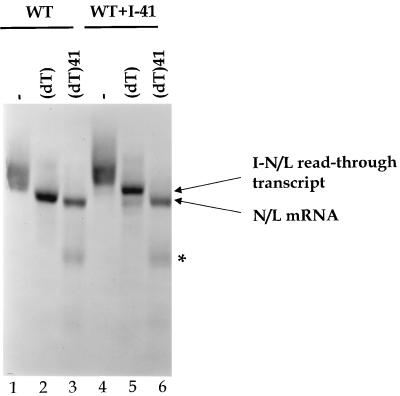FIG. 2.
Identification of the RNAs synthesized by subgenomic replicons. Cells were infected with vTF7-3, transfected with cDNAs for subgenomic replicon WT (lanes 1 to 3) or WT+I-41 (lanes 4 to 6) along with plasmids encoding the VSV N, P, and L proteins, and exposed to [3H]uridine (33 μCi/ml) in the presence of actinomycin D (10 μg/ml) as described in Materials and Methods. Cytoplasmic extracts were prepared, and RNAs were annealed with the indicated strand- and sequence-specific oligonucleotides prior to exposure to RNase H as described in Materials and Methods. The resultant RNAs were analyzed by electrophoresis on agarose-urea gels and visualized by fluorography as described in Materials and Methods. Lanes 1 and 4, no oligonucleotide; lanes 2 and 5, oligo(dT); lanes 3 and 6, oligo(dT) and a negative-sense oligonucleotide designed to anneal to the entire I-41 mRNA and the first 10 nt of the N/L mRNA. Under the conditions used, this latter oligonucleotide, which was designed to anneal to the entire I-41 mRNA and the first 10 nt of the N/L mRNA, appears to mediate some cleavage of the N/L mRNA to yield a product of approximately 200 nt (∗). This presumably reflects inefficient hybridization of this large oligonucleotide at a suboptimal site within the N/L mRNA which results in its cleavage by RNase H.

